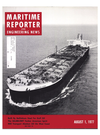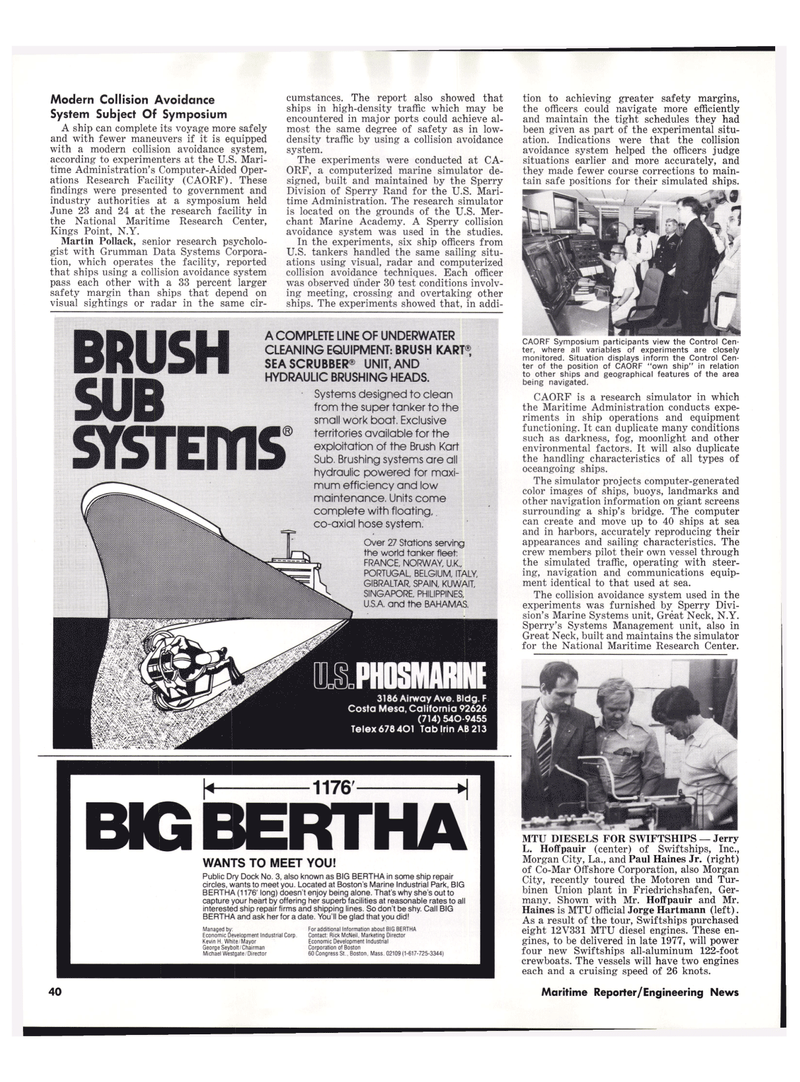
Page 38: of Maritime Reporter Magazine (August 1977)
Read this page in Pdf, Flash or Html5 edition of August 1977 Maritime Reporter Magazine
Modern Collision Avoidance
System Subject Of Symposium
A ship can complete its voyage more safely and with fewer maneuvers if it is equipped with a modern collision avoidance system, according to experimenters at the U.S. Mari- time Administration's Computer-Aided Oper- ations Research Facility (CAORF). These findings were presented to government and industry authorities at a symposium held
June 23 and 24 at the research facility in the National Maritime Research Center,
Kings Point, N.Y.
Martin Pollack, senior research psycholo- gist with Grumman Data Systems Corpora- tion, which operates the facility, reported that ships using a collision avoidance system pass each other with a 33 percent larger safety margin than ships that depend on visual sightings or radar in the same cir- cumstances. The report also showed that ships in high-density traffic which may be encountered in major ports could achieve al- most the same degree of safety as in low- density traffic by using a collision avoidance system.
The experiments were conducted at CA-
ORF, a computerized marine simulator de- signed, built and maintained by the Sperry
Division of Sperry Rand for the U.S. Mari- time Administration. The research simulator is located on the grounds of the U.S. Mer- chant Marine Academy. A Sperry collision avoidance system was used in the studies.
In the experiments, six ship officers from
U.S. tankers handled the same sailing situ- ations using visual, radar and computerized collision avoidance techniques. Each officer was observed under 30 test conditions involv- ing meeting, crossing and overtaking other ships. The experiments showed that, in addi-
BRUSH SUB
SYSTEiriS
A COMPLETE LINE OF UNDERWATER
CLEANING EQUIPMENT: BRUSH KARF
SEA SCRUBBER® UNIT, AND
HYDRAULIC BRUSHING HEADS.
Systems designed to clean from the super tanker to the small work boat. Exclusive territories available for the exploitation of the Brush Karl-
Sub. Brushing systems are all hydraulic powered for maxi- mum efficiency and low maintenance. Units come complete with floating, co-axial hose system.
Over 27 Stations serving the world tanker fleet:
FRANCE, NORWAY. U.K.,
PORTUGAL, BELGIUM, ITALY.
GIBRALTAR, SPAIN, KUWAIT,
SINGAPORE, PHILIPPINES,
U.S.A. and the BAHAMAS. 3186 Airway Ave. Bldg. F
Costa Mesa, California 92626 (714) 540-9455
Telex 678 401 TablrinAB213 1176' H BIG BERTHA
WANTS TO MEET YOU!
Public Dry Dock No. 3, also known as BIG BERTHA in some ship repair circles, wants to meet you. Located at Boston's Marine Industrial Park, BIG
BERTHA (1176' long) doesn't enjoy being alone. That's why she's out to capture your heart by offering her superb facilities at reasonable rates to all interested ship repair firms and shipping lines. So don't be shy. Call BIG
BERTHA and ask her for a date. You'll be glad that you did!
Managed by: For additional Information about BIG BERTHA
Economic Development Industrial Corp. Contact: Rick McNeil. Marketing Director
Kevin H. White/Mayor Economic Development Industrial
George Seybolt/Chairman Corporation of Boston
Michael Westgate/Director 60 Congress St.. Boston. Mass. 02109(1-617-725-3344) tion to achieving greater safety margins, the officers could navigate more efficiently and maintain the tight schedules they had been given as part of the experimental situ- ation. Indications were that the collision avoidance system helped the officers judge situations earlier and more accurately, and they made fewer course corrections to main- tain safe positions for their simulated ships.
CAORF Symposium participants view the Control Cen- ter, where all variables of experiments are closely monitored. Situation displays inform the Control Cen- ter of the position of CAORF "own ship" in relation to other ships and geographical features of the area being navigated.
CAORF is a research simulator in which the Maritime Administration conducts expe- riments in ship operations and equipment functioning. It can duplicate many conditions such as darkness, fog, moonlight and other environmental factors. It will also duplicate the handling characteristics of all types of oceangoing ships.
The simulator projects computer-generated color images of ships, buoys, landmarks and other navigation information on giant screens surrounding a ship's bridge. The computer can create and move up to 40 ships at sea and in harbors, accurately reproducing their appearances and sailing characteristics. The crew members pilot their own vessel through the simulated traffic, operating with steer- ing, navigation and communications equip- ment identical to that used at sea.
The collision avoidance system used in the experiments was furnished by Sperry Divi- sion's Marine Systems unit, Great Neck, N.Y.
Sperry's Systems Management unit, also in
Great Neck, built and maintains the simulator for the National Maritime Research Center.
MTU DIESELS FOR SWIFTSHIPS — Jerry
L. Hoffpauir (center) of Swiftships, Inc.,
Morgan City, La., and Paul Haines Jr. (right) of Co-Mar Offshore Corporation, also Morgan
City, recently toured the Motoren und Tur- binen Union plant in Friedrichshafen, Ger- many. Shown with Mr. Hoffpauir and Mr.
Haines is MTU official Jorge Hartmann (left).
As a result of the tour, Swiftships purchased eight 12V331 MTU diesel engines. These en- gines, to be delivered in late 1977, will power four new Swiftships all-aluminum 122-foot crewboats. The vessels will have two engines each and a cruising speed of 26 knots. 40 Maritime Reporter/Engineering News

 37
37

 39
39
